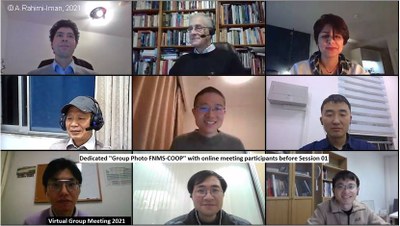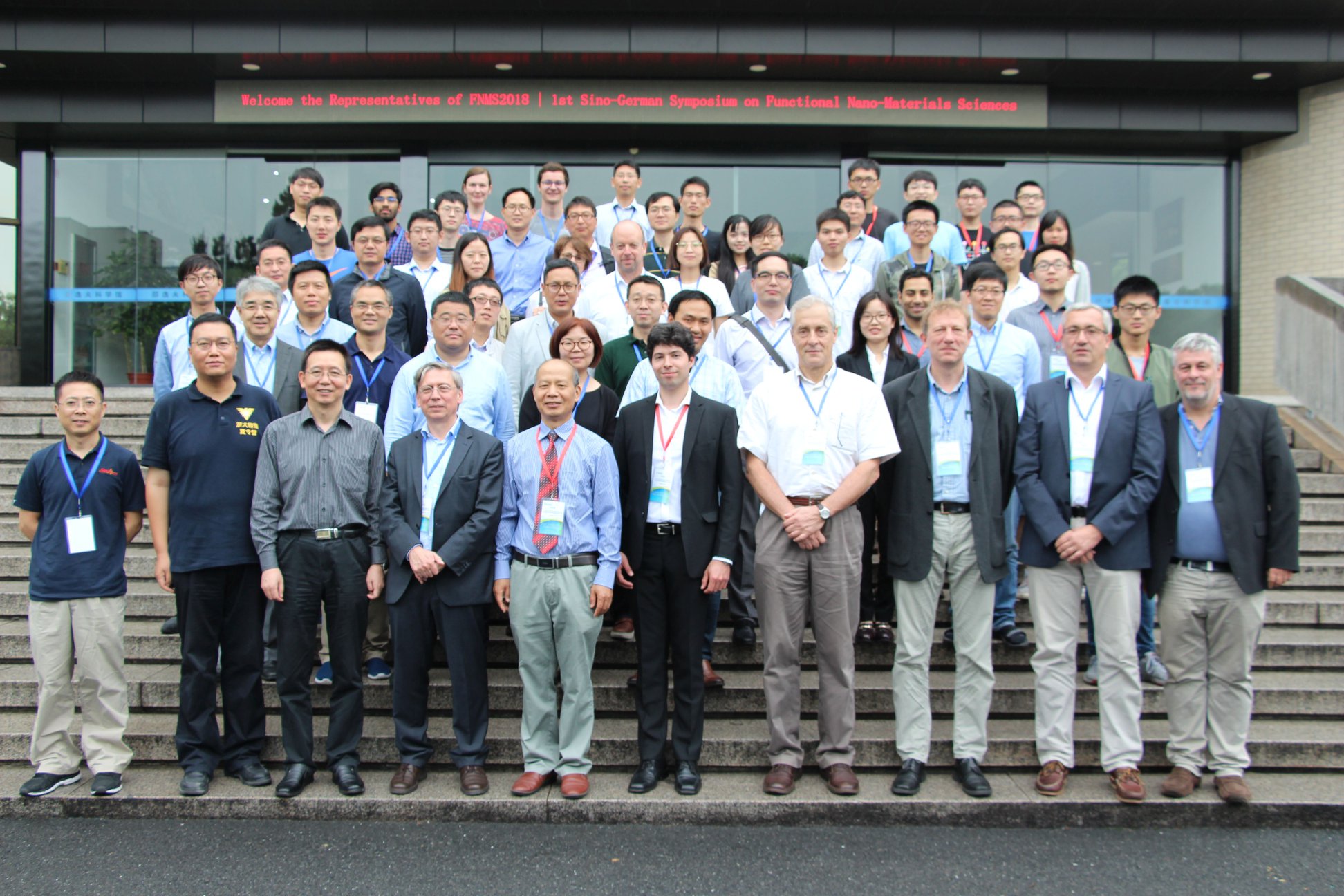Chinesisch-Deutsche Kooperationsgruppe
Sino-German Cooperation Group on Functional Nano-Materials Science (FNMS-COOP)
- Recent FNMS-COOP Research Highlights
-
W. Lai et al., "Omnidirectional Broadband Terahertz Wave Antireflection Based on a
PEDOT:PSS/Graphene Hybrid Coating", ACS Appl. Mater. Interfaces 14, 43868 (2022)
W. Lai et al., "Broadband, optically transparent and highly flexible multispectral beam splitter based on Ag nanowires/graphene composite film for hybrid optical systems," J. Phys. D: Appl. Phys. 54, 295102 (2021)
S. Qin et al., "A new strategy to improve the performance of MoS2-based 2D photodetector by synergism of colloidal CuInS2 quantum dots and surface plasma resonance of noble metal nanoparticles," Journal of Alloys and Compounds 856, 158179 (2021)
- Virtual Group Meeting 2021
- The dedicated "Group Photo FNMS-COOP" with online meeting participants before Session 01 is shown here to the side. During the virtual meeting, presentations were given regarding "Novel Materials and Novel Physics", as well as "Physics and Engineering", discussing various subjects ranging from single-photon sources and graphitic materials to infrared detectors and perovskite solar cells.
- Joint Unversity Teaching
- We are pleased to keep up and extend our lasting cooperation in university-level course teaching by members of our Sino-German Cooperation Group: With hope for an improved health situation, partners from the Zhejiang University and the Giessen University group look forward to more successful joint lecturing activities, such as in 2018 in China (see external link http://opt.zju.edu.cn/opten/2018/1119/c36439a1583541/page.htm "Semiconductor Quantum Structures for Photonic Devices") and 2020-2021 online in BigBlueButton ("Quantum Technology" via Marburg University).
- "Optoelectronic Functional Nano-Materials" Special Issue
-
Joint FNMS-COOP Endeavour: ‘Materials’ Journal Special Issue “OE-FNM-SI”
This Special Issue aims to bringing together professionals and academics performing advanced research on materials with outstanding optical and optoelectronic properties that have the potential to positively shape the information-processing and energy-demanding world of tomorrow. The main purpose is to collect innovative and original contributions targeting modern challenges in optoelectronics and photonics.
- Established Functional Nano-Materials Cooperation
-
After having identified a variety of core competences of the attendees of the 1st Sino-German Symposium Functional Nano-Materials Sciences in Hangzhou (FNMS-2018), the recently forged and similarly-named Sino-German Cooperation Group aims at the establishment of a platform for fruitful collaborations in the field of functional nano-materials sciences research. The initiators and the members of the Cooperation Group wished to make efficient use of the experience obtained through joint research endeavors prior to the formation of this FNMS-COOP Group in order to expand cooperative work in the field of nanophysics and materials sciences. In this newly set frame, the partnering groups envisioned to build on the friendship and mutual trust formed between the project-supported group leaders and institutes in both countries for the establishment of a strong team in the domains of, both, fundamental and applied research on functionalized nano-materials and optoelectronic devices thereof – with the aim of exploring 2D-system photodetectors and sensors among others. The groups involved are characterized by their complementary expertise and methodology. The two co-chairs of the FNMS-COOP Sino-German Cooperation Group also acted and continue to act as program chairs for the Sino-German Symposia series on Functional Nano-Materials Sciences, the first of which (FNMS-2018) was successfully carried out in Hangzhou 2018.
- The FNMS-COOP Group
-
The Cooperation Group comprises multiple research groups from China and Hessia, Germany. Among them are scientists from the Zhejiang University (embedded in two State Key Laboratories, one of Modern Optical Instrumentation and the other one of Silicon Materials), from Beijing’s National Center for Nanoscience and Technology, from Baoding City, Frankfurt and Giessen.
- Further reading: FNMS
- A. Rahimi-Iman (2020): Advances in Functional Nano-Materials Sciences, Annalen der Physik 532, 2000015 (https://doi.org/10.1002/andp.202000015): "Technologies employing nanomaterials, such as electronics, optoelectronics, nanobiotechnologies, quantum optics, and nanophotonics, are perceived as the key drivers of investigations on novel and functional materials and their nanostructures for various applications. It is well understood that the study of such materials and structures..."
- Shared FNMS Promotion
- International Office - Philipps-Universität Marburg (on 30. Mai 2018): 'Wir gratulieren Dr. Arash Rahimi-Iman, Fachbereich Physik der UMR, und Prof. Huizhen Wu zur erfolgreichen Durchführung des ersten gemeinsamen "Sino-German Symposium on Functional Nano-Materials Science".' (see external link https://de-de.facebook.com/IO.UMR/photos/wir-gratulieren-dr-arash-rahimi-iman-fachbereich-physik-der-umr-und-prof-huizhen/1965126940468393/)
- Sino-German Symposium FNMS-2018
-
The Group Photo of FNMS-2018 in Hangzhou is one representative aspect of the Sino-German Symposium FNMS-2018, which aimed at bringing together experts of more than two countries and at supporting the rise of a future generation of scientists, young leaders in their field of research. More details about the event are found in our brief summary here: external link to the CDZ homepage article on the FNMS-2018 Symposium (http://www.sinogermanscience.org.cn/de/aktuelles/de_2018/201806/t20180626_489284.html).
The topics of interest presented at the 1st Sino-German Symposium on Functional Nano-Materials Science are visualized in the graphical chart below. More details about the image "Trending Keywords FNMS2018" and related content are found in the review article here: external link to the journal Annalen der Physik (https://onlinelibrary.wiley.com/doi/10.1002/andp.202000015)
- Trending Keywords FNMS2018
- Image source(s): Left diagram with central insets from "Advances in Functional Nanomaterials Science," Ann. Phys. 532(9), 2000015 (2020) [ https://doi.org/10.1002/andp.202000015 ], Copyright 2020, A. Rahimi-Iman, published by Wiley-VCH under a CC-BY-4.0 International Licence. Upper right inset with micrograph of a monolayer tungstendisulfide flake: Adapted under the terms of the CC-BY-3.0 International Licence (http://creativecommons.org/licenses/by/3.0/). 2D Mater. 4, 025045 (2017) [ https://doi.org/10.1088/2053-1583/aa5b21 ] Copyright 2017, IOP Publishing Ltd. Lower right inset with image of a schematic colloidal nanoparticle on graphene: Adapted under the terms of the CC-BY-4.0 International Licence (http://creativecommons.org/licenses/by/4.0/). Sci. Rep. 6, 28224 (2016) [ https://doi.org/10.1038/srep28224 ] Copyright 2016, Springer Nature.
- Chinese Co-Chair of the FNMS-COOP
- Prof. Dr. Huizhen Wu (ZJU, Hangzhou)
- Contact FNMS
-
Functional-Nano-Materials-Sciences Groups Coordination
Huizhen Wu
Professor at the Department of Physics
State Key Laboratory of Silicon Materials
Zhejiang University, Hangzhou
Hangzhou, P. R. China Giessen
HZWU [at] zju.edu.cn
- German Co-Chair of the FNMS-COOP
- Dr. Arash Rahimi-Iman (JLU, Giessen)
- Contact QNP and FNMS
-
Quantum Nanophotonics AI-Enhanced Group &
Functional-Nano-Materials-Sciences Groups Coordination
Arash Rahimi-Iman
Heisenberg Group Leader at I. Physikalisches Institut
Justus-Liebig-Universitaet Giessen
Tel.: +49 (0) 641 99 33124
Sekr.: +49 (0) 641 99 33101
Arash.Rahimi-Iman [at] physik.jlug.de
- Supported by:
- The Sino-German Center for Research Promotion / Chinesisch-Deutsches Zentrum für Wissenschaftsförderung (CDZ). The Emblem of the CDZ shown: Link to the (external) CDZ Webpage.
- FNMS-COOP Results
- FNMS-COOP: Forschungsergebnisse / Research Outcomes







